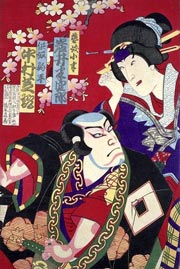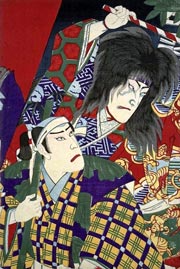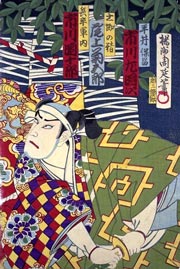| TSUCHI-GUMO |
| Play title | Tsuchi-gumo |
| Authors | Kawatake Mokuami Hanayagi Jusuke II (choreography) Kineya Sh˘jir˘ III (music) |
| History |
The dance-drama "Tsuchi-gumo", an adaptation to Kabuki of the eponymous N˘ play, was premiered in June 1881 at the Shintomiza to commemorate the 32nd anniversary (33rd memorial service) of late Onoe Kikugor˘ III [casting]. |
| Key words |
Aragoto Chisuji no Ito Kumo Kumo no Sei Kumo Taiji Matsubamemono Minamoto Yorimitsu Nagauta Raik˘ Sakata Kintoki Shinko Engeki Jűsshu Shitenn˘ Shitenn˘mono Shosagoto Tsuchi-gumo Urabe Suetake Usui Sadamitsu Watanabe Tsuna Yamai Hachimaki |
| Summary |
At the start of the play Yasumasa appears and announced that his lord has been ill, but that he is now thought to be improving thanks to services of intercession at various temples. The lord, Yorimitsu, enters. Then comes Koch˘, bringing some medicine which was specially prepared for him. When she asks about his illness, he replies that he is feeling better. Nevertheless, to cheer him up and help him recover, she dances. At the end Yorimitsu thanks her and she withdraws. Left alone except for his sword-bearer, Yorimitsu's body begins to quake. The light dims, and from the darkness comes a priest. Taken aback, Yorimitsu inquires how he came there. The mysterious priest replies that he has come because he heard that Yorimitsu wishes for services to be held for his recovery. Yorimitsu expresses his thanks, and the priest approaches to begin such a service. Just as the sword-bearer notices something strange about the priest's shadow, darkness envelopes them continuing to advance towards Yorimitsu, the priest tries to cast a web around him. Despite his illness, Yorimitsu manages to draw his sword, Hizakirimaru [the knee-cutting sword], and slashes the priest. Yasumasa rushes to the rescue, but too late. The priest has already disappeared. Yasumasa organizes an expedition and follows a trail of blood to the spider-priest's lair, a wooden framework with a moss-covered thatched roof. This symbolizes an old tomb in which the spider has taken refuge. Yasumasa accompanied by four warriors, known as the Four Heavenly Kings, arrives in front of the tomb. Hearing a groan from inside, they guess that the spider-priest is hiding there. In the usual manner of medieval warriors before a battle, they cry out their names and challenge the spider to a fight. Accepting their challenge, the spider emerges and boasts that it will destroy Yorimitsu as a first step towards world domination. Employing superhuman powers, it casts its web upon them, binding them more and more tightly. But as the wounded monster begins to tire, Yasumasa swiftly gives it a death blow with Hizakirimaru, which thereafter becomes known as Kumokirimaru [the spider cutting sword]. This summary has been written by Watanabe Hisao and edited by Jeff Blair [website] |
 |
 |
 |
|
The actors Nakamura Shikan IV, Iwai Hanshir˘ VIII, Ichikawa Danjűr˘ IX, Onoe Kikugor˘ V and Ichikawa Sadanji I playing the roles of the yakko Komahei, the geisha Kohan, the soldier Gunnai, the spirit of the Ground Spider and Hirai Yasumasa in the dance-drama "Tsuchi-gumo", which was staged in June 1881 at the Shintomiza (print made by Y˘shű Chikanobu) |
||
|
|
| Contact | Main | Top | Updates | Actors | Plays | Playwrights | Programs | Links | FAQ | Glossary | Chronology | Illustrations | Prints | Characters | Derivatives | Theaters | Coming soon | News |